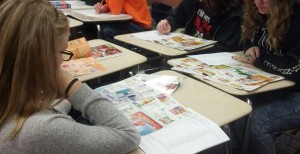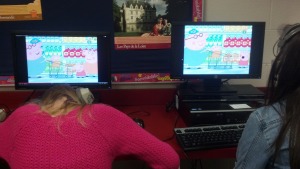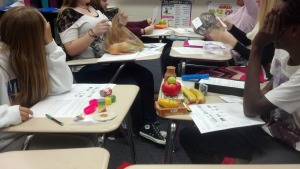
Happy Halloween!
Although I’ve embraced many aspects of middle age, I’m still a kid at heart when it comes to celebrating Halloween. In spite of the fact that my husband and I have been empty nesters for several years, our house is the most decorated one on the block, and we’re more excited than most children when we choose our costumes each year. Fortunately, most of my students get as excited as I do about Halloween, so I make sure to set aside a week or so each year on Halloween-themed activities. Although most of my authentic texts come from children’s books and magazines that I can’t share, here are a few activities that some of you might be able to use.
1. Vocabulary List & Flashcards Vocab_list & flashcards
This document includes the vocabulary list that I hand out with pictures and words, as well as the pictures without the words. I printed 30 copies of this version on tagboard several years ago and cut each one apart so I can hand out a baggie of picture cards to each student for review games such as Bingo, Memory, and Go Fish.
2. Vocabulary Review Worksheet Vocabulary review (novice)
I’ve used this worksheet with French 2 students. Although the “choose the word that doesn’t belong” format is traditional in nature, it does encourage interpersonal communication when students are allowed to work in small groups.
3. Same/Different Pair Activity Halloween same_different
I think I got a little carried away when I made this one up! (I could have probably stopped after the first 10 pictures, but I was having too much fun!). To use this activity, you will first have to cut the table down the middle (or reconfigure the table), and number each picture (1-25). The first column is given to Partner A and the second column to Partner B. The pairs must discuss their pictures in order to decide whether they have the same or different picture for each number. (I have them write #1-#25 on loose-leaf and write Même or Différent next to each number).
4. Halloween Videos Halloween Videos
On this document I’ve included English comprehension question for several Halloween-related YouTube videos. Included are two stories (L’Ogre qui avait peur des enfants and Franklin fete l’Halloween) as well as two news videos. I have used these videos with French 3 students.
In addition to these activities, my students will read authentic stories (titles depend on the proficiency level), and the French 3 students will read authentic articles about the history of Halloween, bats, and spiders.
I’d love to hear back from those of you who incorporate Halloween into your lesson planning. What resources have you used with your students?
Category Archives: Planning
Six Reasons Why I Love Learning Stations
Although I have left behind many of the teaching strategies that I relied on earlier in my career, some techniques continue to be valuable in a proficiency-oriented classroom. A strategy that I continue to implement is the use of learning stations. A recent French 2 unit on grocery shopping reminded me of the following advantages of incorporating learning stations into my classroom instruction.
#1: Learning stations enable me to incorporate authentic materials in their most authentic form. While the internet gives us access to limitless authentic materials, actual concrete objects that were brought back from the target country are inherently interesting to students. They love seeing the French price tags on items that I’ve purchased and always want to know whether I’ve “stolen” items such as menus and other realia. It is often difficult, though, to procure enough of an authentic item for the entire class to use simultaneously. However, if I divide my class into small groups, a few grocery flyers, for example, are sufficient for an interpretive task. 
#2: Learning stations allow me to make the most of the technology I have available to me. I have eight computers in my classroom. When I divide my classes of 25-30 students into 4-5 different station groups, I am able to have my students use the classroom computers to access authentic videos for interpretive listening tasks. The students shown here are able to watch their Peppa le Cochon video at their own pace, pausing and rewinding as necessary in order to improve their comprehension.

#3: Learning stations allow me to incorporate manipulatives into my lessons. While it would be cost prohibitive (and a storage nightmare) to buy enough play food to use for these grocery store role-plays, learning stations made it possible for these students to use the play food that I do have, as well as some spare euro coins, to lend authenticity to their interpersonal task for the unit. In other units I’ve been able to use authentic and teacher-created games that would not be possible with an entire class. 
#4: Learning stations allow me to provide better feedback to my students. During the learning station phase of a unit, I generally position myself near the students who are either practicing the interpersonal task for the IPA. In this way I am able give the students very specific feedback on their progress, which I would not be able to do if I were circulating among an entire class who was working on the same task. By having my students write drafts for their presentational task at a learning station, I am also able to give them more detailed feedback, as I have only about seven or eight papers each evening, rather than a set of 30.
#5: Learning stations give me a little breathing space. While each set of learning stations requires a lot of advanced preparation on my part, once we begin this phase of instruction, my work is basically done. There are no copies to be made at the end of the day, a new agenda does not need to be written on the board, etc.
#6: Learning stations allow me to show off a little. There are many times that we need to be able to demonstrate our best practices to others. This might be for a graduate class, evaluation by an administrator, or National Board Certification. It is always a challenge to decide what those evaluators will see during the short time they will be spending in our classroom or watching us on a video. When we invite others to see our students working on learning stations, they can see how we teach all modes of communication, 21st century skills, several state standards, etc. in a single lesson. When required, we also have a lot to reflect about when a single lesson includes so many different activities.
These are only a few of the advantages of using learning stations in a proficiency-based classroom. If you use learning stations, I’d love to hear the reasons why!
Food for Thought
The title of this post comes not only from the fact that I have prepared a couple of food-related French 2 lessons to share, but because I have been doing a lot of reflecting on the changes that I have been making in order to focus more on increasing student proficiency. When a colleague asked me what I meant by proficiency-based teaching, I realized that I could not explain in only a sentence or two what this term meant to me. Since even a Google search did not identify a universal definition or specific methodology, I can only share what I have been doing and how the paradigm shift has worked in my classroom. To see specific examples of the types of lessons I’ve designed, please see my other posts on this blog.
Curriculum: The most important change that I have made is to develop a curriculum that is totally independent of any textbook series. In the absence of this resource to guide my instruction, I chose ten to twelve broad themes for each of the classes (Level 1-5) that I teach. I then follow the following steps to create a unit for these themes.
Step 1: Choosing the unit goals
In order to ensure that I’m choosing appropriate goals for each of these thematic units, I rely heavily on the ACTFL Can-Do Statements for the targeted proficiency level of the class. For French 1 I am beginning with Novice Low statements, but will transition into Novice Mid later in the year. In French 2 I use mainly Novice High statements, in French 3 I use Intermediate Low-Mid, and in AP I use Intermediate Mid-High. In many cases I can use an exact statement as a goal, but when necessary I modify a statement to reflect the content of the unit. In this way I am essentially filling in the blank line after the prepared statements.
Step 2: Choosing the authentic texts
In planning the learning activities for each unit, I have relied heavily on Amy Lenord’s description of the authentic lesson cycle (http://www.amylenord.net/authentic-lesson-cycle.html). Based on my understanding of her ideas, I select an authentic text for each lesson and then create interpretive, interpersonal, and presentation tasks related to the text. I have found that each lesson cycle takes about two to three class days, so I choose about four authentic texts for each unit. This enables me to cover a unit, including the IPA, in about three weeks.
I begin my search for authentic texts for these lessons by checking the Pinterest boards I have created for each theme. Relying on my colleagues to pre-select relevant, high-interest and appropriate texts has saved me countless hours of research. As described in my earlier posts, I rely heavily on infographics, especially for novice learners and to introduce a theme. Based on the proficiency level of the students, I also use children’s magazine articles, children’s stories, and lots of web-based materials.
In addition to these written texts, I also choose authentic recorded texts related to the theme of the unit. Usually videos, these texts might not be directly related to the written text, they do reflect the theme of the unit. In my lower level classes, I use lots of cartoons, because their visual nature provides important context for the novice learners. Some of my favorites are Trotro l’Ane, Petit Ours Brun, Caillou, and Tchoupi et Doudou. Youtube searches on each of these characters will reveal the titles of several different episodes, many of which complement commonly used themes. With my Intermediate students, I usually opt for news videos or other more formal recorded materials.
Step 3: Creating the learning activities
After choosing each text, I develop an interpretive reading task based on the template provided by ACTFL in Implementing Integrated Performance Assessment (http://www.actfl.org/publications/guidelines-and-manuals/implementing-integrated-performance-assessment). Based on the text I have chosen, I will use some or all of the sections on this template. I do not personally feel that this template works for well for listening, so I usually develop basic comprehension questions for the videos I use, although I try to include multi-level (main idea, supporting detail, inference) questions.
After preparing the comprehension guides for the interpretive tasks, I develop the interpersonal tasks that the students will complete after reading and listening. For my Novice learners, I usually provide personalized questions based on the reading that they will ask a partner. For the Intermediate students, I write more open-ended discussion questions related to the information in the text.
For the last step of each lesson, I design at least one presentational task. For this activity, I give the students some type of scenario related to the authentic text (usually the written one), and they respond in writing or orally.
Although I have been mostly pleased with these lessons, I’ve found that adding a vocabulary-building game or other not-quite-authentic activity here and there helps to add a little bit of variety while still increasing proficiency. As the year progresses I hope to find the right balance between these types of activities.
Step 4: Integrated Performance Assessment (IPA)
Since each lesson is essentially a “Mini IPA,” this type of assessment works well in my classes. In addition, my students are very comfortable with IPA’s, because I began implementing them last year, as a result of some professional development that I had done. Although I am describing the IPA as Step 4, it is actually the first step that I complete when designing the unit. By writing the IPA before creating any of the other lessons, I can ensure that each task prepares the students for what they will be expected to do on the IPA.
Before beginning an IPA, I give the students a day or two to prepare. During this stage, I give them time to practice the interpersonal task (although they will not be allowed to choose their partner on the actual IPA) and to write rough drafts of the presentational writing task. My interpersonal IPA tasks are less structured than the tasks that I assign for the individual lessons. For example, rather than a set of specific questions, I will give them only a general situation or theme and they will be required to ask the appropriate questions to develop the conversation. Based on the needs of the students, I might also give them time to practice some of the specific skills needed for the IPA during this time. For example, in a recent French 1 unit on school supplies, I gave the students time to complete interactive vocabulary activities on the computer in addition to the rough draft and interpersonal practice time.
When writing the IPA, I again begin by choosing both an authentic written and recorded text, and then creating a comprehension guide, based on the ACTFL template. The students usually complete these two tasks on the first day of the IPA. On Day 2, I assign the final draft of the presentational written task and then call up pairs of students to my desk for the interpersonal assessment.
While these steps seem to be working well for me so far, only time will tell whether they will enable my students to meet the proficiency goals I have set for them. I’d love to hear back from any of you that have developed other methods of increasing student proficiency in your classrooms!
In the meantime, here are a couple of examples of authentic lessons from my current French 2 unit on Mealtimes.
lalimentation-vegetarienne
le temps de l’alimentation
Separation Anxiety: Planning a Novice Low unit without even looking at the textbook.
With less than two weeks before school starts I’m trying to get my first couple of units planned for each of the four courses that I teach. As I continue on my journey to leave the textbook behind in favor of a proficiency-based approach, I find the beginners (French 1) the most challenging group. There’s something a little scary about being solely responsible for deciding what they need to know at each step along the way!
As I planned their curriculum for the year, I decided that after a week or so spent on greetings, I would begin by teaching them the vocabulary and structures they would need to talk about school supplies. It seemed to me that if they successfully acquired this vocabulary, it would be an important first step in my maintaining a 90% target language classroom.
I began the process of planning this unit by choosing the authentic materials that I would use to introduce the vocabulary to the students. As you can see by downloading the link below, I came up with an office supply website, two YouTube videos where teens presented their new school supplies, and a school supply list from a French middle school.
For each of these resources I developed both Interpersonal and Presentational tasks to reinforce the vocabulary from the Interpretive activity. Each of these tasks will result in a formative assessment, as I will collect and assess the Interpretive tasks (Reading/Listening), assess some of dyads for the Interpersonal tasks (by spending a few minutes with various pairs as they complete the task), randomly select pairs to orally present the information gleaned from the interpersonal task (Presentational-Speaking), and collect and assess the Presentational Writing task.
Although I did not have a specific grammatical/structural goal for this unit, I found that I was incorporating the verb avoir into most of the interpersonal activities that I developed– an important novice level structure. While I haven’t yet written the Integrated Performance Assessment for this unit, I feel comfortable that I can expect the students to use this structure (at least the first and second person singular forms) on the interpersonal task on this evaluation.
If you are looking for proficiency-based activities to teach school supply vocabulary to French 1 students, feel free to use any of these activities—and make sure to let me know how it goes!
Here’s the document with the activities: schoolsupplieslessons
For those of you who are farther along in the process of proficiency-based teaching, please consider sharing the process you use to plan a unit without relying on the vocabulary/structures presented in the textbook.
I’ll look forward to hearing from you!
Three steps to creating a proficiency-based unit
1. Define your goals for the unit. I begin this step by choosing a level-appropriate NCSSFL-ACTFL Global Can-Do Benchmark (http://www.actfl.org/global_statements) for each mode of communication. I then modify the benchmark to correspond to the theme of the unit. For example, for a French 2 unit on daily routine, I chose the following Novice Mid Benchmarks:
Interpretive Reading: I can sometimes understand the main idea of published materials.
Interpretive Listening: I can understand simple information when presented with pictures and graphs.
Interpersonal Communication: I can communicate some basic information about my everyday life.
Presentational Speaking: I can talk about my daily activities using words, phrases, and memorized expressions.
Presentational Writing: I can write about myself using learned phrases and memorized expressions.
I then modified the original benchmarks based on the daily routines theme, so that the students were given the following goals at the beginning of the unit:
Interpretive Reading: I can understand an article about someone’s daily activities.
Interpretive Listening: I can understand a cartoon about a character’s daily activities.
Interpersonal Communication: I can discuss my daily activities. Presentational Speaking: I can talk about my daily activities. Presentational Writing: I can write about my daily activities
2. Create the Integrated Performance Assessment (IPA) for the unit.
I include at least one task for each mode of communication on the IPA.
Interpretive Mode I begin by choosing the authentic resources that the students will read and/or listen to on the IPA. At the Novice students need lots of pictures, cognates, and familiar vocabulary so I use mostly children’s magazines, children’s websites, infographics, and cartoons for my novice-level French 1 and 2 students. My intermediate-level French 3-4/5 students can usually interpret a variety of authentic web-based articles and videos. After choosing the resource, I develop the comprehension guide that I will use to assess the students. For the reading assessment, I use the template provided in the ACTFL publication, Implementing Integrated Performance Assessment (http://www.actfl.org/publications/guidelines-and-manuals/implementing-integrated-performance-assessment). My listening assessment is usually a series of English comprehension questions which rely heavily on previously-learned vocabulary and the visual content of the cartoon. In addition, I include questions that require the students to infer the meaning of new words.
Interpersonal Mode For this portion of the IPA, I usually call two students to my desk and listen to them as they perform the task I have developed for the IPA. Most of my interpersonal tasks are guided conversations, but I also use role plays, debates, etc., in upper level classes. Although I give the students the prompt in advance, they do not know who their partner will be so they are not able to memorize a dialogue. I generally give each pair about 3 minutes for their conversation.
Presentational Mode In most cases, I choose a written assessment for the presentational mode, as I have already assessed my students’ speaking in the interpersonal task. I give the students the prompt in advance and usually assign a draft on which I provide written feedback as a formative assessment.
Here’s the IPA I created for my French 2 unit on daily routines. French 2 IPA
3. Create the learning activities that will prepare the students to be successful on the IPA.
Many of my learning activities are similar to “mini IPA’s” in which the students interpret an authentic resource, discuss it with a partner/small group, and present the content in written or spoken form. However, as I consider these tasks formative assessments, I provide feedback, but no grade on these tasks. I also include vocabulary-building activities and grammar instruction on an as-needed basis. Please share your ideas about unit planning by replying to the link given above!
